Communication Process & Tools
•
3 gostaram•2,056 visualizações
This presentation describes the communication process as well the tools of communication. Enlisting every step of communication and how the message travels.
Denunciar
Compartilhar
Denunciar
Compartilhar
Baixar para ler offline

Recomendados
Recomendados
Mais conteúdo relacionado
Mais procurados
Mais procurados (20)
Semelhante a Communication Process & Tools
Semelhante a Communication Process & Tools (20)
Communication definition and Process of Communication.pptx

Communication definition and Process of Communication.pptx
Último
https://app.box.com/s/7hlvjxjalkrik7fb082xx3jk7xd7liz3TỔNG ÔN TẬP THI VÀO LỚP 10 MÔN TIẾNG ANH NĂM HỌC 2023 - 2024 CÓ ĐÁP ÁN (NGỮ Â...

TỔNG ÔN TẬP THI VÀO LỚP 10 MÔN TIẾNG ANH NĂM HỌC 2023 - 2024 CÓ ĐÁP ÁN (NGỮ Â...Nguyen Thanh Tu Collection
Último (20)
ICT Role in 21st Century Education & its Challenges.pptx

ICT Role in 21st Century Education & its Challenges.pptx
Unit-V; Pricing (Pharma Marketing Management).pptx

Unit-V; Pricing (Pharma Marketing Management).pptx
On National Teacher Day, meet the 2024-25 Kenan Fellows

On National Teacher Day, meet the 2024-25 Kenan Fellows
Python Notes for mca i year students osmania university.docx

Python Notes for mca i year students osmania university.docx
TỔNG ÔN TẬP THI VÀO LỚP 10 MÔN TIẾNG ANH NĂM HỌC 2023 - 2024 CÓ ĐÁP ÁN (NGỮ Â...

TỔNG ÔN TẬP THI VÀO LỚP 10 MÔN TIẾNG ANH NĂM HỌC 2023 - 2024 CÓ ĐÁP ÁN (NGỮ Â...
Micro-Scholarship, What it is, How can it help me.pdf

Micro-Scholarship, What it is, How can it help me.pdf
Fostering Friendships - Enhancing Social Bonds in the Classroom

Fostering Friendships - Enhancing Social Bonds in the Classroom
ICT role in 21st century education and it's challenges.

ICT role in 21st century education and it's challenges.
Kodo Millet PPT made by Ghanshyam bairwa college of Agriculture kumher bhara...

Kodo Millet PPT made by Ghanshyam bairwa college of Agriculture kumher bhara...
General Principles of Intellectual Property: Concepts of Intellectual Proper...

General Principles of Intellectual Property: Concepts of Intellectual Proper...
Basic Civil Engineering first year Notes- Chapter 4 Building.pptx

Basic Civil Engineering first year Notes- Chapter 4 Building.pptx
Mixin Classes in Odoo 17 How to Extend Models Using Mixin Classes

Mixin Classes in Odoo 17 How to Extend Models Using Mixin Classes
Communication Process & Tools
- 2. “Communication must be HOT. That is Honest, Open and Two-Way.” -Dan Oswald “The most important thing in communication is to hear what isn’t being said.” -Peter Drucker
- 3. • It is a process of transmitting and receiving verbal and non verbal messages. • Communication is considered EFFECTIVE when it receives the desired reaction or response from the receiver. Simply stated… Communication is a two-way process of exchanging ideas or information Business Communication differs from other types of communication, not by its means of communicating, but by its objectives
- 4. Components of Effective Communication Sender/ Encoder Context Message Medium FeedbackReceiver
- 5. Context • The aspect of context is the playing field on which we must plan design and communicate our message successfully. • A major aspect of context basically tells us the reason for communication, which can be - Internal : Discussion of an idea/issue with its employees by the company. The message either has to be written or verbal. - External : A communication from the outside of the organisation, be it a query from the stakeholders or a discussion with a client.
- 6. Sender/Encoder • When you send a message, you are the encoder, the writer or speaker. • The writer decides whether the message should be in a written or an oral form. • The sender may use words, symbols, pictures or graphics, that express the objective in real sense. • After all considerations, the sender decides the best possible channel of medium which would ensure an effective communication.
- 7. Message • Message is basically the idea that the sender wishes to communicate. • The message can be verbal or non verbal (i.e. Written, symbols, pictures) • Being one of the most important component of communication, the message must be legible, clear and easily understandable. • Clear decisiveness on the main points of the message and the information to be included helps. • Relationship between the sender and receiver is an important consideration while composing the message.
- 8. Medium • Medium is basically the channel through which your message receiver • Channels vary from situations to situations. • Just like message, a couple of factors are considered while opting for a medium, such as Relationship between sender/receiver, Urgency of the message, Number of receivers, Cost & Amount of Information • The audience of the message can make a difference, o Inside the Organisation : A sort of an internal communication within the organisation o Outside the Organisation : Letters, reports, proposals, emails, press releases, etc.
- 9. Receiver/ Decoder • The message receiver is the reader or the listener, also known as the decoder. • Many of the messages may have more than one decoder. • The receiver is influenced by context and by his/her mental filter.
- 10. Feedback • If your communication get the proper response from the receiver, it means you have effectively conveyed the message. • That response/reaction from the receiver after getting the message is called feedback. • Feedback can be oral or written, sometimes silence is used as feedback, though it is almost always ineffective. • Senders need feedback in order to determine the success or failure of the communication.
